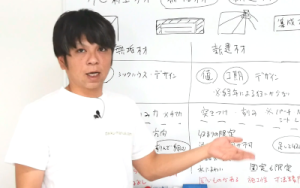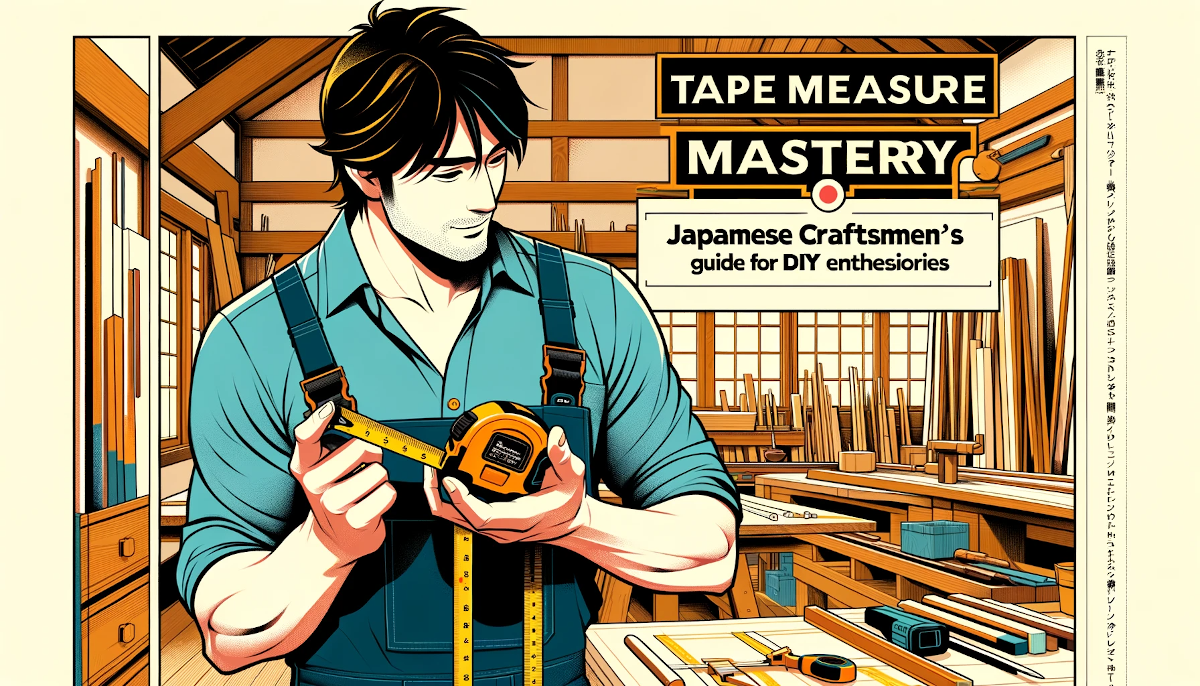From professionals to DIY enthusiasts, the tape measure is an indispensable tool in the world of craftsmanship. In this edition, we’ll unveil a collection of techniques and effective tips on handling the tape measure, straight from Japanese artisans. We will also present a plethora of skills that are easily replicable even for beginners, hoping to expand the horizons of your crafting endeavors.
日本語版の記事(コンベックス(スケール)の使い方や選び方【プロの大工が解説】)はコチラ
List of Contents
Article Author

Kentarou Fukata
A Kyoto, Japan native born in 1985, I am a seasoned carpenter boasting five national qualifications in housing-related disciplines in Japan. Committed to the dissemination of carpentry expertise, I actively contribute to professional development within the field through instructional content on YouTube.
Intro Video: Mastering the Tape Measure
Complementing the guide is an informative video designed to augment comprehension.
If you wish to utilize features like subtitles, please reopen the video on YouTube. You can access the subtitles through the ‘CC’ button on the playback screen or in the settings.
The tape measure’s three essential roles and characteristics

We will delineate three essential attributes crucial for a tape measure in carpentry applications to ensure optimal utilization of the tool.
Precision in Measurement: Ensuring Accuracy
In interior construction work where high precision is required, a tape measure that is off by even 1mm is of no use. To maintain accuracy, meticulous handling is essential. It bears the characteristic of a consumable: if damaged, it must be replaced, as there is no alternative.
Portability: For immediate measuring and marking
As measurement is a fundamental element of the manufacturing process, a tape measure becomes an essential tool to carry at all times during work. A key consideration when carrying it is to prevent the tool from dropping and damaging the finish materials. It’s crucial to choose a tape measure that is secure against accidental drops, yet readily accessible and usable when needed.
Interior Priority: Emphasizing Use in Interior Settings
In the realm of house construction, especially in interior work, a high level of finishing precision is demanded. Consequently, the choice of tape measure, which significantly affects the accuracy of the work, is prioritized for interior tasks. An interior-specific type is selected. Metal tape measures are vulnerable to rain, so for exterior construction work, tape measures that are no longer suitable for interior use, but not yet discarded, are utilized.
Basic Handling of the Tape Measure
Let’s introduce the fundamental handling techniques to extend the life of your tape measure and enhance work efficiency.

Always Pinch the Tape
When holding the tape measure, always grip it in a way that your fingers pinch the tape. This allows you to control the retraction speed with your fingers, preventing injuries from aggressive retraction and avoiding damage to the tape’s hook.
Tips for Prolonging the Life of Your Tape Measure
Do Not Bend the Tape Backwards
The tape of a tape measure can be bent concavely, but not convexly. Bending it convexly can lead to cracks or breaks in the tape.
Do Not Step on the Tape
Stepping on the tape can cause it to bend or damage the painted surface. Moreover, in the culture of Japanese carpentry, it’s considered disrespectful to step on or sit on tools. Through craftsmanship, we hope you take an interest in the Japanese culture and mindset as well.
Be cautious not to wet it.
Iron tape measures are susceptible to water damage, risking rust on the tape or corrosion on the spring when exposed to moisture. It’s crucial, especially during outdoor work in rainy conditions, to promptly wipe and dry the tape if it gets wet.
Tips for Measuring with a Tape Measure

Techniques for Measuring Internal Dimensions
When measuring the internal dimensions of a wall with a tape measure, the tape tends to bend at the interior corner on the tape measure’s side, reducing measurement accuracy. In such cases, mark an easy-to-remember measurement (like 1m or 2m) from one side, measure the distance from that mark to the opposite side, and then add both measurements to find the internal dimension.
Measuring Unreachable Areas
When it’s necessary to measure dimensions in areas beyond your reach, extend the tape and handle it as if it were a stiff ruler. Specifically, secure the hook at the starting point, then unroll the tape so that the part of the tape near the main body juts out, touching the point you wish to measure. This approach allows you to measure areas that are otherwise inaccessible.
Temporary Markings for Error Prevention
Misinterpreting measured dimensions or misrecalling noted measurements can directly lead to operational failures. In situations where precision is paramount, placing temporary pencil marks on the tape during measurement and repeatedly verifying them can significantly minimize the risk of errors or mishaps.
Tips for Ink Marking and Dimension Splitting

Utilizing the Lock Feature
A tape measure, equipped with a hook at the zero point, makes it challenging to measure accurately in places where the hook is impractical. In such situations, it’s advisable to measure without the hook and then calculate the length. Specifically, align the tape at the 10cm mark with your starting point, extend it to your endpoint, and then deduct 10cm from the resulting measurement. In this context, the lock feature proves to be incredibly handy. By engaging the lock function, you can enjoy hands-free mobility, which allows for measuring in a visibly comfortable position.
Shaku: Embracing Japanese Measurement Units
The width of boards and veneers commonly handled by Japanese carpenters follows the standard of 910 mm, approximately “3 shaku.” “3 shaku” easily divides into 2 divisions = “1.5 shaku,” 3 divisions = “1 shaku,” 4 divisions = “0.75 shaku,” 5 divisions = “0.6 shaku,” and 6 divisions = “0.5 shaku,” making calculations straightforward, even for long spans.
If you want to measure from the middle of the wall, simplifying the process can be achieved by fixing a nail at the starting point to hook the tape measure.
Quick and Simple Parallel Line Drawing
Using a tape measure allows for swift drawing of parallel lines on materials. Specifically, place a pencil against the hook of the tape and hold it there while pinching the tape at the point where you want the parallel line. Rest the pinching fingers against the side of the material and slide along, much like using a marking gauge, letting the pencil at the hook side make the mark. Exercise caution with materials like plywood, as wood splinters can easily embed in your sliding fingers.
The Correct Way to Choose a Tape Measure

Exploring the Fundamental Features of a Tape Measure
The ability to automatically adjust for the thickness of the hook
The hook plate of a tape measure is about 1mm thick. When using the hook for both hooking and pushing measurements, a discrepancy arises due to the thickness of the hook plate. Tape measures are standardly equipped with a feature that automatically fine-tunes this discrepancy.
Carrying Clip and Strap
Tape measures come equipped with a clip that can be attached to a belt for easy transportation, and a strap designed to prevent accidental drops when held by hand.
Key Considerations in Selecting a Tape Measure

Tape measures are utilized across various industries, each catering to the specific needs of different sectors with specialized features. Consequently, this section summarizes the crucial elements to consider when selecting a tape measure for carpentry work.
Stiffness of the Tape for 2 Meter Extension
In interior work, selecting a tape with high rigidity is crucial to minimize sagging when extended. The opportunity to measure distances of 2 to 3 meters is frequent, and the ideal tape measure is one that allows for these measurements to be taken accurately and effortlessly on its own.
Material of Tape and Coating
The recommended material for tape measures is the standard type made of steel with a painted finish. While stainless steel as a material boasts high corrosion resistance, stainless steel tapes tend to be less durable than expected. They are prone to bending and their surfaces are susceptible to peeling. Furthermore, they are comparatively expensive and the tape itself is too soft, making them less suitable for carpentry work.
Lock & Stop Function
For a tape measure, which is utilized by pinching the tape, a button-activated stop function is redundant. However, the lock function is crucial. It facilitates hands-free measuring and marking, enhancing convenience and efficiency in various tasks.
Cost-Performance Ratio
As tape measures are consumable tools, it’s advisable to opt for reasonably priced options that include all the necessary features. Tape measures are tools that are carried around constantly and are therefore prone to damage. It’s often more prudent to replace a broken tape measure with a new, even if inexpensive, one rather than continue using a costly but faulty tape measure. The ability to maintain high precision with the ease of replacement makes affordability a significant factor in the selection process.

Portability
The tape measure, a tool ubiquitously used in various professions, comes with a plethora of holder options. For instance, there are types designed with magnets for belts. While convenient, their susceptibility to falling makes them less suited for carpenters who navigate through finished materials. I prefer to carry my tape measure in a tool belt, choosing a design that is compact and straightforward to avoid crowding the space within the belt.
Scale Markings (Shakkan-ho System)
Many building materials handled by Japanese carpenters conform to the shaku standard. Utilizing scale markings in shaku makes the division and calculation of measurements significantly more straightforward. Additionally, shaku markings are characterized by their ease of readability. With millimeter markings, notations are made in 100 mm increments, and scale marks are indicated in 10 mm increments (for 510 mm, you read 50 cm and 10 mm). However, with shaku markings, numbers are inserted every sun (1/10 shaku), so a measurement of 2 shaku and 3 sun is simply denoted as 23 sun. This system offers benefits such as readability at challenging distances and a reduced likelihood of significant reading errors.
Protective Protrusion for Hook Prevention
Tape measure hooks are inherently prone to damage, leading to some designs featuring protective protrusions on the body to prevent bending or breaking. However, in interior work where one-handed operation of the tape measure is common, these protrusions can make it challenging to hook the tape with just one hand. While it’s desirable to avoid damage to the hook, it’s for reasons like these that I personally avoid choosing tape measures with these protrusions.
Double-Sided Scale Printing on Tape
Some tape measures feature scale markings printed on both sides of the tape. Personally, I don’t find this feature particularly necessary. Situations where measurements can only be taken from the reverse side are rare, making it less of a significant advantage.
Hook with Magnetic Feature
Some tape measures are equipped with a hook featuring a magnet. This feature is intended for professions that involve working with iron, such as scaffolding and light-gauge steel construction. In carpentry, the opportunity to utilize this feature is minimal. More often, it becomes an inconvenience by adhering to unintended metal surfaces, making it an unnecessary feature for interior work.
Introducing the Optimal Tape Measure for Carpentry Work
Includes promotional content.
Tape measure with shaku-scale markings.
Introducing the ‘GOATSU’ tape measure by the Japanese manufacturer ‘Tajima,’ complete with a lock feature. This model boasts a remarkably robust tape and a straightforward design. While the tape length is a slightly shorter 5 meters, it’s the perfect length for interior work.
Featuring mm scale markings
The standard ‘Tajima’ ‘GOATSU’ model (with mm markings) comes highly recommended for DIY projects. We encourage you to try out this Japanese-made tape measure at least once.
Tape Measure Guide Conclusion
Did you find anything useful in this guide? The role of a tape measure in craftsmanship is immensely important. Skillfully utilizing a tape measure is key to enhancing both quality and productivity. Even with a familiar tool like a tape measure, focusing on skill can make the process of creation much more enjoyable. We support your wonderful craftsmanship.


